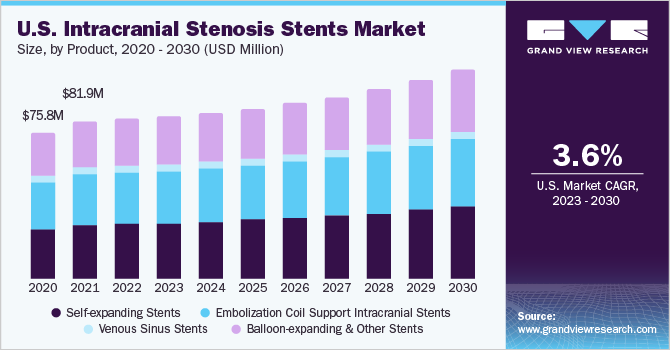Intracranial Stenosis Stents Market To Reach USD 1.1 Billion By 2030
Intracranial Stenosis Stents Market Growth & Trends
The global intracranial stenosis stents market size is
expected to reach USD 1.1 billion by 2030 and is expected to expand at 4.8%
CAGR from 2023 to 2030, according to a new report by Grand View Research, Inc.
Stroke is a leading cause of death and morbidity in the U.S. as well as
globally. Large artery atherosclerosis is responsible for approximately 20% of
all ischemic strokes, with nearly 50% of them being intracranial, and the
condition has a comparatively high recurrence rate, regardless of medical
treatment.
Furthermore, nearly 10% of ischemic strokes in the U.S. and up to
50% in Asia are caused by intracranial stenosis. The actual incidence of
Intracranial Atherosclerotic Disease (ICAD) might be greater because
symptomatic, non-stenosing atherosclerotic plaques may go undiagnosed with the
current diagnostic methods. As per a study report, an autopsy analysis of
stroke patients showed a significant number of intracranial non-stenosing
atherosclerotic plaques, approximately 6% of which had superimposed thrombi and
were presumed to be accidental results of an ischemic event.
Moreover, compared to Americans, Hispanics, Africans & Asians
have higher rates of ICAD. The disparity in ICAD prevalence by race and
ethnicity is probably caused by variations in risk factor profiles, dietary
habits, and genetic predispositions. For instance, a study attributed the
higher prevalence of hypertension, hyperlipidemia, and diabetes mellitus in
African American patients to the high prevalence of ICAD.
A few major advantages of minimally invasive procedures include:
- These procedures
cause less discomfort and postoperative pain
- Unlike
conventional surgeries that make use of large openings, minimally invasive
procedures rely on small openings
- Minimally
invasive procedures result in a shorter hospital stay
- These procedures
result in fewer scars
As per a research study on 169 patients, published in the
Radiological Society of North America, 20 individuals (11.8%) faced
complications. 10.5% of the individuals had a stroke (4 patients had symptomatic
intracranial hemorrhages [ICHs]; 6 patients had an ischemic stroke) and two of
these patients died. Two patients had asymptomatic ICHs and one had a transient
ischemic attack, while the other had an asymptomatic dissection.
In Europe, there have been concerns about the shortage of skilled
professionals in interventional neuroradiology. For instance, a study published
in the European Journal of Neurology in 2018 found that there
is a need for more training programs and resources to support the development
of expertise in this area. The study also found that the shortage of skilled
professionals can limit access to specialized treatments, such as intracranial
stenosis stenting, for patients with neurological disorders.
Request a free sample copy or view report summary: https://www.grandviewresearch.com/industry-analysis/intracranial-stenosis-stents-market-report
Intracranial Stenosis Stents Market Report Highlights
- Self-expanding
stents dominated the overall market with 34.9% of the revenue share in 2022.
Intracranial stenosis self-expanding stents are designed to open the
narrowed areas and improve the blood flow in the brain. These stents have
proven to be an effective treatment option as they have a high success
rate with a low complication rate
- The hospital
segment held the largest market share of 80.8% in 2022. Intracranial
stenosis procedures are complicated and critical surgeries, which depend
on high-quality durable equipment available in hospitals. However,
increasing preference for minimally invasive endovascular procedures in
hospitals has led to the rising adoption of intracranial stents for
stenosis patients
- Ambulatory
surgical centers are anticipated to showcase the fastest growth rate over
the forecast period. These facilities offer patients with shorter hospital
stays, quality hospitalization in stroke units, and lower readmission
rates
- The growth of
the market in North America can be attributed to the presence of advanced
healthcare facilities in the region, an increasing preference for minimally
invasive procedures, the rising prevalence of atherosclerosis & brain
strokes, the growing geriatric population, and the presence of key
industry players
Intracranial Stenosis Stents Market Segmentation
Grand View Research has segmented the global intracranial stenosis
stents market based on product, end-use, and region:
Intracranial Stenosis Stents Product Outlook (Revenue,
USD Billion, 2018 - 2030)
- Self-expanding
Stents
- Embolization
Coil Support Intracranial Stents
- Venous Sinus
Stents
- Balloon-expanding
& Other Stents
Intracranial Stenosis Stents End-use Outlook (Revenue,
USD Billion, 2018 - 2030)
- Hospitals
- Ambulatory
Surgical Centers
- Others
Intracranial Stenosis Stents Regional Outlook (Revenue,
USD Billion, 2018 - 2030)
- North America
- U.S.
- Canada
- Europe
- UK
- Germany
- France
- Spain
- Italy
- Sweden
- Norway
- Denmark
- Asia Pacific
- China
- Japan
- India
- South Korea
- Australia
- Thailand
- Latin America
- Brazil
- Mexico
- Argentina
- MEA
- South Africa
- Saudi Arabia
- UAE
- Kuwait
List of Key Players in the Intracranial Stenosis Stents Market
- phenox GmbH
- Medtronic
- Acandis GmbH
- MicroPort
Scientific Corporation
- MicroVention,
Inc.
- CERENOVUS
(Johnson & Johnson)
- Sino Medical
Sciences Technology, Inc.
- Stryker
- Balt
Browse Full Report: https://www.grandviewresearch.com/industry-analysis/intracranial-stenosis-stents-market-report

Comments
Post a Comment